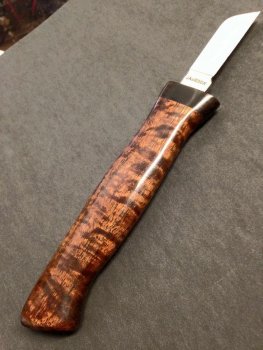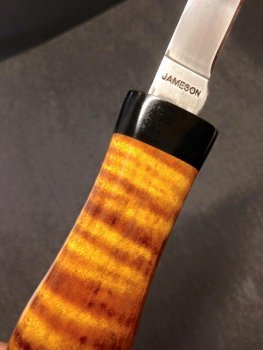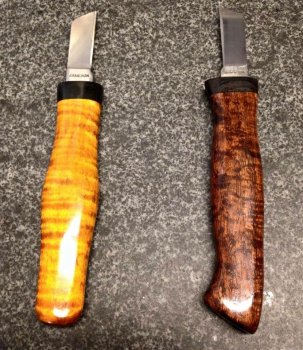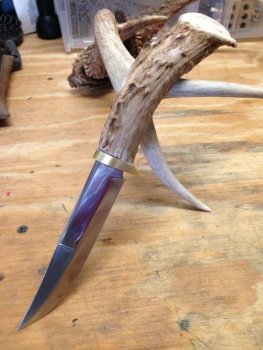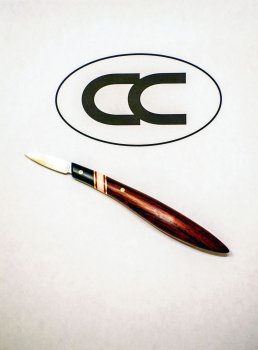Chris623
Well-Known Member
I'm in the process of making a carving knife for myself right now. Decided to put the extra time into it to make it uniquely mine. This is the first stacking of materials I've done on a knife handle. So I'm stacking, front to back, Gabon Ebony, .040" brass, .040" red fiber, 1/4" Walrus Ivory, .040" red fiber, .040" brass and the balance of the handle is Cocobolo. I'm using System Three Quick Cure 5 Epoxy. (supposedly a 5 minute epoxy) I've had this epoxy on the shelf for a year or so...................might it be "dated"? It seems to set up hard overnight.
I glued my stack with epoxy and let it set overnight. Then I cut it in half lengthwise and rabbited a slot for the blade in one half. Used C-clamps to hold it together while I shaped the outline of the handle with a belt sander. It seems when the epoxy gets hot, it "lets go". I've had two joints fail so far.
I've had two joints fail so far.  Finally decided I was going to get the piece/pieces that fall off epoxied back on and drill pin holes for the blade. When I tried to put the first pin through the handle half to align hold the blade for drilling of the second hole, the Ebony broke off.
Finally decided I was going to get the piece/pieces that fall off epoxied back on and drill pin holes for the blade. When I tried to put the first pin through the handle half to align hold the blade for drilling of the second hole, the Ebony broke off.  I'm going to install the blade and Epoxy both halves together and then see if I can finish shaping the handle.
I'm going to install the blade and Epoxy both halves together and then see if I can finish shaping the handle.
Am I approaching this wrong? Am I using the wrong Epoxy. I don't think I starved the joint of epoxy when I clamped it...........but who knows?
Any help from you guys who stack materials would be greatly appreciated.
I glued my stack with epoxy and let it set overnight. Then I cut it in half lengthwise and rabbited a slot for the blade in one half. Used C-clamps to hold it together while I shaped the outline of the handle with a belt sander. It seems when the epoxy gets hot, it "lets go".
Am I approaching this wrong? Am I using the wrong Epoxy. I don't think I starved the joint of epoxy when I clamped it...........but who knows?
Any help from you guys who stack materials would be greatly appreciated.


